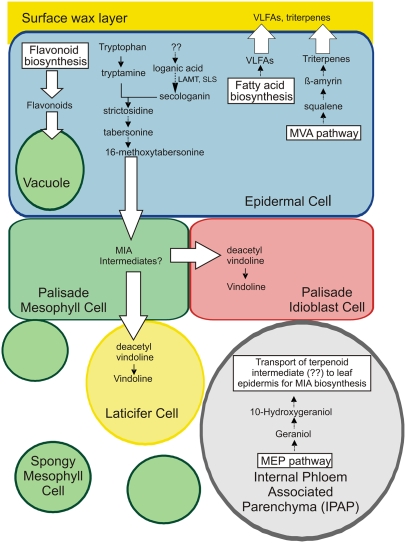Figure 9.
Catharanthus Leaf Epidermal Cells Express the MIA, MVA/Triterpene, VLFA, and Flavonoid Biosynthetic Pathways.
The EST sequencing analysis described in this study suggests that the complete MVA/triterpene pathway is expressed in leaf epidermal cells and that the triterpenes being produced are exported outside the cell into the surface of the leaves. Similarly the entire pathway for VLFA biosynthesis is also expressed in this cell type and is exported to produce the surface wax layer of Catharanthus leaves. Flavonoid biosynthesis also appears within these same epidermal cells where flavonoid products accumulate within epidermal cell vacuoles as suggested by Mahroug et al. (2006). The model also proposes that most of the vindoline pathway up to and including 16-methoxytabersonine is expressed in the leaf epidermis and an undetermined intermediate is then transported to adjacent mesophyll cells, specialized idioblasts, and/or laticifers, for final elaboration into vindoline. To permit this complex transport, strict control mechanisms appear to be operating and these have yet to be characterized. In contrast with leaf epidermal cells that are enriched in the MVA pathway that supplies IPP for the biosynthesis of triterpenes, there is strong evidence that the IPAP cells preferentially express the MEP pathway and G10H. This raises questions about the roles played by these two cell types in supplying the necessary IPP for the biosynthesis of secologanin within the leaf epidermis.

